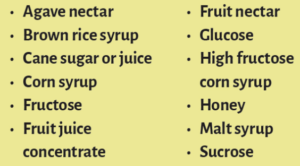Sneaky Sugar!
Read the label: Small fruit drinks may be convenient for little kids, but they can hide a large amount of sugar
Alaska parents say that one reason they serve their little kids sugary drinks is convenience. When a toddler says she’s thirsty, there’s a pack of drink pouches in the pantry. The toddler grabs one, punches a straw through the top and starts drinking.
Parents are on their way out the door — dad headed to work and his 3-year-old to be dropped off at preschool. It’s the morning rush, so he grabs a small bottle of a fruit drink and slides it into the backpack.
Common drinks have too much sugar
While convenient, these grab-and-go drinks are often loaded with added sugar that can lead to cavities, type 2 diabetes, unhealthy weight gain, even heart disease. A 6-ounce drink pouch can have about 3 teaspoons of sugar. A 10-ounce bottle of a fruit drink can have 8 teaspoons. A 12-ounce can of soda can even more — 10 teaspoons. Families often buy vitamin drinks and sports drinks in even larger-sized, 20-ounce bottles. That sports drink can come with 9 teaspoons of added sugar, and the vitamin drink with 8.
This summer, Play Every Day is sharing new videos, online and print messages to help Alaska families figure out how much sugar is hiding in drinks and to promote drinking water or milk instead. In just 30 seconds, we use a common sweet treat to show how much sugar is in a small fruit drink. This new video shows a 3-year-old girl stacking up mini doughnuts next to a cranberry raspberry drink. Then you hear the message: “A small fruit drink can have the same amount of sugar as 8 mini doughnuts. You wouldn’t let your children eat that much sugar, so why let them drink it?”
Our new handout includes this infographic to show the amount of sugar in drinks commonly served to little kids.

How much sugar is too much?
The most recent U.S. Dietary Guidelines for Americans recommend limiting the amount of sugar your kids eat and drink to less than 10 percent of their daily calories. For preschool-age children, that means limiting added sugar to fewer than 8 teaspoons a day. As the infographic shows, the sugar from drinks alone can take kids over the recommended limit, and that doesn’t include the added sugar little kids also get from foods.
Added sugars can be tricky to spot because these sweeteners go by many different names. They’re called high fructose corn syrup, honey, glucose, sucrose and other names:

Read the drink label. Check the back of the bottle to see how much added sugar is in your drink. If sugar or any other sweetener is listed in the first three ingredients, your drink is likely loaded with sugar.
Serve healthy drinks at home and on the go
Unlike sugary drinks, water and white milk have no added sugar. They are the healthiest drink choices for children, and they can be just as convenient.
- You can keep cold pitchers of water in the fridge so water is ready whenever kids are thirsty.
- You can add slices of fruit or mint to water to give it flavor.
- On your way out the door, you can put a refillable bottle of water in your child’s backpack.
- You can pack store-bought water bottles, too, but in many Alaska communities, you can drink water straight from the tap or filter it using special pitchers.
Children want to drink what their parents drink. Parents can be role models and choose healthy options. In child care centers and preschools, caregivers can show toddlers and preschoolers how they choose healthy drinks, too.